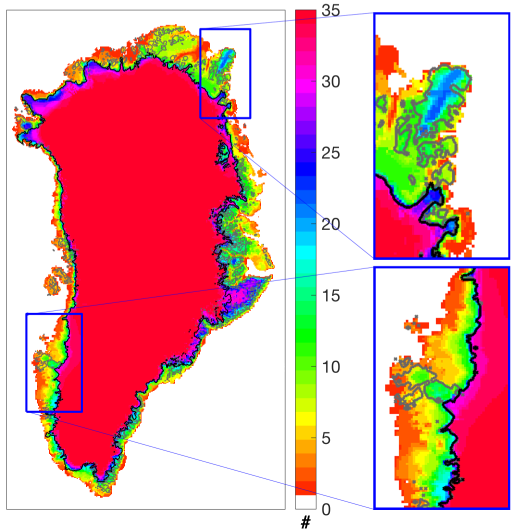Ice2ice researcher Christian Rodehacke is co-author on a new article in The cryosphere investigating different models of Greenland ice sheet and how they compare.
We have compared a wide spectrum of different initialisation techniques used in the ice sheet modelling community to define the modelled present-day Greenland ice sheet state as a starting point for physically based future-sea-level-change projections. Compared to earlier community-wide comparisons, we find better agreement across different models, which implies overall improvement of our understanding of what is needed to produce such initial states.
The full study can be found here.

Common ice mask of the ensemble of models in the in-
tercomparison. The colour code indicates the number of models
(out of 35 in total) that simulate ice at a given location. Outlines
of the observed ice sheet proper (Rastner et al., 2012) and all ice-
covered regions (i.e. main ice sheet plus small ice caps and glaciers;
Morlighem et al., 2014) are given as black and grey contour lines,
respectively.
Goelzer, H., Nowicki, S., Edwards, T., Beckley, M., Abe-Ouchi, A., Aschwanden, A., Calov, R., Gagliardini, O., Gillet-Chaulet, F., Golledge, N. R., Gregory, J., Greve, R., Humbert, A., Huybrechts, P., Kennedy, J. H., Larour, E., Lipscomb, W. H., Le clec’h, S., Lee, V., Morlighem, M., Pattyn, F., Payne, A. J., Rodehacke, C., Rückamp, M., Saito, F., Schlegel, N., Seroussi, H., Shepherd, A., Sun, S., van de Wal, R., and Ziemen, F. A.: Design and results of the ice sheet model initialisation initMIP-Greenland: an ISMIP6 intercomparison, The Cryosphere, 12, 1433-1460, https://doi.org/10.5194/tc-12-1433-2018, 2018.